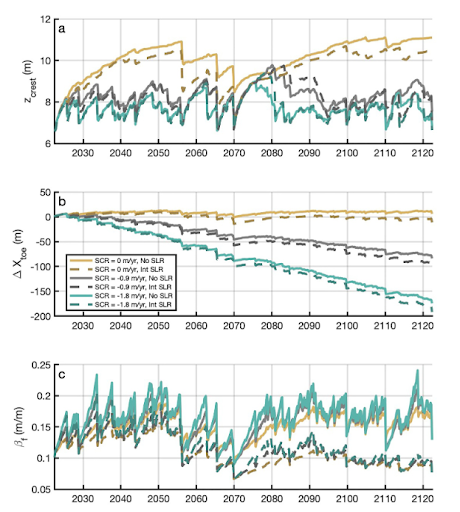A new National Centers for Coastal Ocean Science (NCCOS)-funded study found that beaches with low wave energy and little erosion are more likely to support growing sand dunes. Dunes can serve as lasting natural barriers to coastal flooding and storm damage and create opportunities to build towards increased coastal protection.

In coastal communities vulnerable to hurricanes and nor’easters, sand dunes are a crucial first line of defense against flooding and storm waves. Researchers in North Carolina’s Outer Banks developed a model that combines wind, wave, and storm condition data to estimate how dunes may grow, or erode, over the next 100 years. The model showed that narrow beaches with high wave activity and elevated water levels experienced long-term dune loss. In contrast, the model demonstrated that wind may contribute to dune growth on beaches that experience little erosion, even when accounting for predicted changes in sea level.
The findings provide coastal managers, developers, and property owners with a new tool for identifying areas where dunes are likely to persist and offer reliable flood protection. For example, homes and infrastructure built near wider, low-erosion beaches with stable or even growing sand dunes may be at lower risk of sustaining damage like flooding during future storms. The model can also help guide smarter investments in dune restoration by identifying locations where restored dunes are most likely to survive over time.
The project is partially funded through the NCCOS Effects of Sea Level Rise Program. Project partners include the U.S. Army Corps of Engineers Engineer Research and Development Center–Field Research Facility, Virginia Institute of Marine Science Coastal Geology Lab, and Virginia Commonwealth University’s Coastal Plant Ecology Lab.
This work is authorized by the NOAA Authorization Act of 1992, Pub. L. 102-567 (Oct. 29, 1992); sec. 201(c), which authorizes appropriation for the NCCOS Competitive Research Program to augment and integrate existing programs of NOAA and shall include efforts to improve predictions of coastal hazards to protect human life and personal property.
Citation: Cohn, N., & Anderson, D. (2025). Projecting the longevity of coastal foredunes under stochastic meteorological and oceanographic forcing. Earth’s Future, 13, e2024EF005335. https://doi.org/10.1029/2024EF005335
